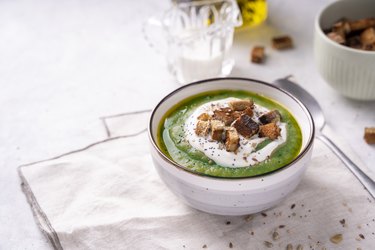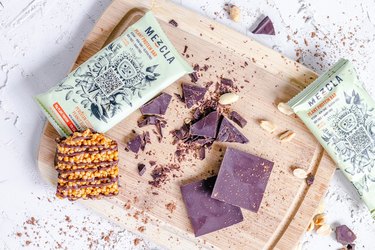Plain steamed crab meat is one of the healthiest seafoods you can eat. For very few calories, crab is a great source of protein. It also has a lot of minerals and B vitamins within it. If you are more likely to get heart disease, you might want to choose certain kinds of crab or limit the amount you eat. Some types of crab have more cholesterol or sodium than others.
Yes, crab meat is healthy! Its full of protein, as well as some essential vitamins and minerals. Be careful with your portions and don’t add too much butter or other high-fat or high-sodium sauces.
Raw crab meat is incredibly low in calories, and almost all of the calories come from protein. Blue crab meat offers just 74 calories from a 3-ounce cooked portion, according to USDA National Nutrient Database.
The same amount of Alaska king crab has about 71 calories, while a 3-ounce serving of Dungeness crab has almost 73 calories. Roughly 85 percent of those calories are from protein. The final percentage of calories are from fat and a small amount from the carbs in crab.
Avoid all that butter or cream sauce to keep your calories and fat to a minimum. According to the USDA National Nutrient Database, adding just one tablespoon of melted butter adds 100 calories. Almost all of those calories come from fat, mostly saturated fat.
Is Crab Meat Bad For You? A Complete Look at the Health Pros and Cons
With its sweet, succulent flavor and meaty texture, crab is one of the most prized seafood delicacies. But if you’re health conscious, you may be wondering – is crab meat bad for you? What are the health pros and cons of eating crab?
In this comprehensive article, we’ll explore the nutritional benefits of crab, potential downsides, and give tips on how to incorporate crab into a healthy diet. By the end, you’ll understand the smart ways to enjoy crab meat as part of balanced eating.
The Nutritional Pros of Crab Meat
First, let’s examine why crab can be a nutritious food choice Some key health benefits include
-
High in protein – Crab is an excellent source of lean protein needed for energy, muscle repair and strength A 3 oz serving provides about 20g protein
-
Low in fat and calories – Compared to beef or cheese, crab meat is low in saturated fat and calories, at around 100 calories per 3 oz.
-
Rich in minerals – Crab contains selenium, zinc, copper, magnesium and phosphorus for bone health, immunity and energy production.
-
Contains omega-3s – The omega-3 fatty acids in crab promote heart health by reducing inflammation and lowering triglycerides.
-
Vitamin packed – Eating crab provides B vitamins like B12, folate, niacin and thiamin for cellular function, energy and neural health.
-
Antioxidants – Compounds like astaxanthin in crab supply antioxidant power to combat disease.
So in terms of nutrition, crab can be an excellent addition to your diet. It provides ample protein with fewer calories and less saturated fat than most meats and many dairy products. The abundance of minerals, omega-3s and vitamins make it a useful food for overall wellbeing.
Potential Downsides of Eating Crab
However, there are some potential cautions to keep in mind with eating crab:
-
High cholesterol – Crab meat contains high amounts of dietary cholesterol, with about 115mg in a 3 oz portion.
-
Sodium content – Crab has naturally occurring sodium, with around 260mg per 3 oz serving. This could be concerning for those limiting salt.
-
Allergies – Some people may be allergic to crab and need to avoid it entirely. Allergy symptoms include hives, swelling and anaphylaxis.
-
Heavy metal exposure – Crabs at the bottom of the food chain can accumulate mercury, cadmium and other heavy metals from pollution, so choose wisely.
-
High purine content – People with gout are sometimes advised to limit crab and other high purine foods which can exacerbate gout symptoms.
So while crab meat has proven nutritional benefits, those with certain health conditions need to be aware of the downsides. Monitoring your cholesterol, sodium intake, possible allergies and gout status should factor into your decisions on eating crab.
Tips for Incorporating Crab into a Healthy Lifestyle
Focusing on balance and moderation is key to gaining the benefits of crab meat while managing any potential negatives. Here are some smart tips:
-
Watch portion sizes – Stick to a 3-4 oz serving of crab a few times per week at most as part of a healthy diet. This provides nutrition without overdoing cholesterol, sodium or purines.
-
Choose sustainable sources – Opt for domestic crab species over imported to reduce likelihood of toxins, pollutants and heavy metals.
-
Prepare it healthfully – Skip the deep frying. Instead, opt for steaming, baking, or sautéing crab with healthy fats like olive oil.
-
Pair it with vegetables – Serve crab with fiber and nutrient-rich veggies like asparagus, brussels sprouts, spinach or broccoli.
-
Limit added salt – Avoid adding extra table salt during cooking or at the table since crab naturally contains sodium.
-
Monitor effects – Pay attention to how crab makes you feel. Limit intake if you experience adverse effects like joint pain, swelling or skin reactions.
With some mindfulness regarding preparation, portion size, and sustainability, crab meat can be part of an overall healthy way of eating for most people.
Crab Meat vs. Ham and Cheese
If you’re debating crab meat versus other animal proteins, how does it compare to ham or cheese health-wise? Here’s a quick look:
Crab:
- Higher in protein than cheese
- Lower in saturated fat than cheese or ham
- Contains omega-3s; ham and cheese do not
- Lower in sodium than ham
- Lower in cholesterol than cheese
Ham and Cheese:
- Higher in calcium than crab
- Ham provides more B12 than crab
- Ham and cheese usually less expensive than crab
- Considered more allergy-friendly than shellfish
Overall, crab meat is the healthier pick due to its high protein content, abundance of minerals like selenium, lower saturated fat, and omega-3 fatty acids. But ham or cheese may fit your budget better or work well if you have a shellfish allergy.
The Verdict on Crab and Your Health
At the end of the day, crab can be part of a nutritious diet for most people when eaten in moderation. Pay attention to portion size, preparation method, and your body’s response. Stick to sustainably-sourced crab from reputable suppliers.
While crab has some excellent nutrition benefits, be cautious with intake if you have heart disease, diabetes, gout or another condition where cholesterol, sodium and purines need restriction. If in doubt, discuss your specific health status with your doctor.
As with any seafood, balance is key. Crab offers protein, healthy fats, vitamins and minerals, but it shouldn’t be your only protein source. Alternate crab with fish, beans, nuts, seeds, poultry and lean meats as part of a varied diet. Listen to your body, buy high-quality crab, and enjoy this tasty treat in sensible amounts as part of your healthy lifestyle. With some care regarding your unique nutritional needs, crab can be a fabulous addition to your meal plan.

High in Saturated Fat
Low-density lipoprotein levels can go up a little if you eat too much cholesterol, but cholesterol in food doesn’t always do that. In addition to having too much cholesterol, eating a lot of saturated fat can cause your bad LDL cholesterol to rise.
Less than 10 percent of your calories, or 7 percent for optimal heart health, should come from saturated fat, as reported in 2015–2020 Dietary Guidelines for Americans. Based on 2,000 calories daily, thats a maximum of either 22 grams or 15 grams. So while raw crab meat is slightly high as far as cholesterol content, it doesnt have much saturated fat. Three ounces of most varieties of steamed crab offer less than 0.2 gram of saturated fat.
Read more: Imitation Crab Meat Nutrition
Cholesterol in Crab Meat
Some consumers may worry about crab meats cholesterol content. Our 2015–2020 Dietary Guidelines say that you shouldn’t have more than 300 milligrams of cholesterol a day, or no more than 200 milligrams if your blood cholesterol is already high.
The amount of cholesterol in three ounces of steamed blue crab is over 66 milligrams. The amount of cholesterol in three ounces of Dungeness crab is about 56 milligrams. Youll get just 36 milligrams of cholesterol from a 3-ounce cooked portion of Alaska king crab.



Health benefits of Crab: Seafood is really healthy for you!
Is crab meat good or bad for You?
Crab meat is noticeably high in omega-3 fatty acids, and while many people assume that all fats are bad for them, omega-3s are the “good” ones that actually balance your cholesterol levels and may promote anti-inflammatory activity throughout the body.
Is it safe to eat crab meat during pregnancy?
It is safe to eat crab meat during pregnancy as long as it comes from a reliable source, with appropriate hygienic and sanitary conditions for pre-preparation, preparation and packaging of this food.
Can you eat the meat from a crab?
Yes, crab meat is edible and is considered a delicacy in many parts of the world.Crab meat is rich in **protein**, **vitamin B12**, **folate**, **iron**, **niacin**, **selenium**, and **zinc** .
Is steamed crab meat healthy?
Plain steamed crab meat is one of the healthiest seafoods you can eat. For a minimal amount of calories, you get lots of protein, the nutrition in crab consists of a multitude of minerals and several B vitamins. You may want to select certain types of crab or keep your serving size small if you are at risk of developing heart disease, though.
